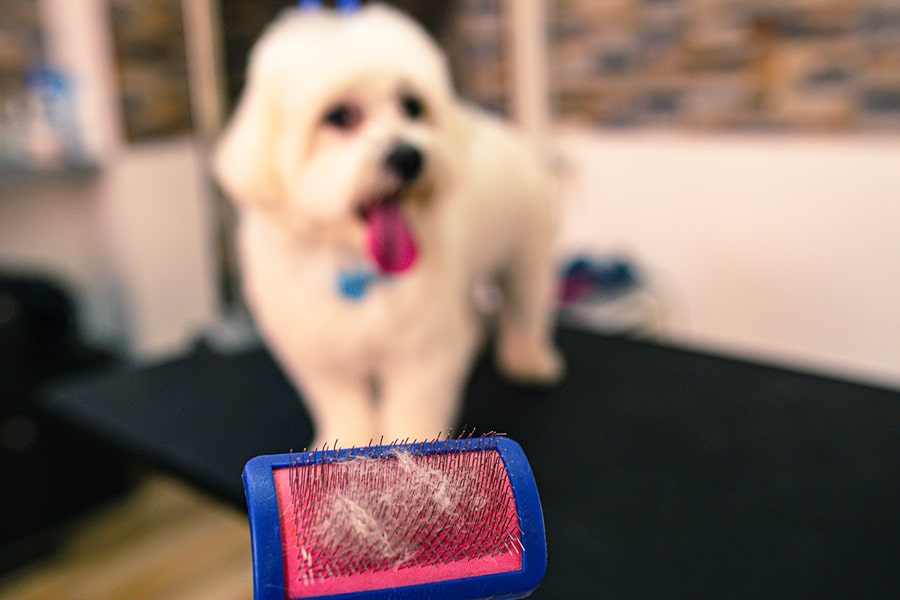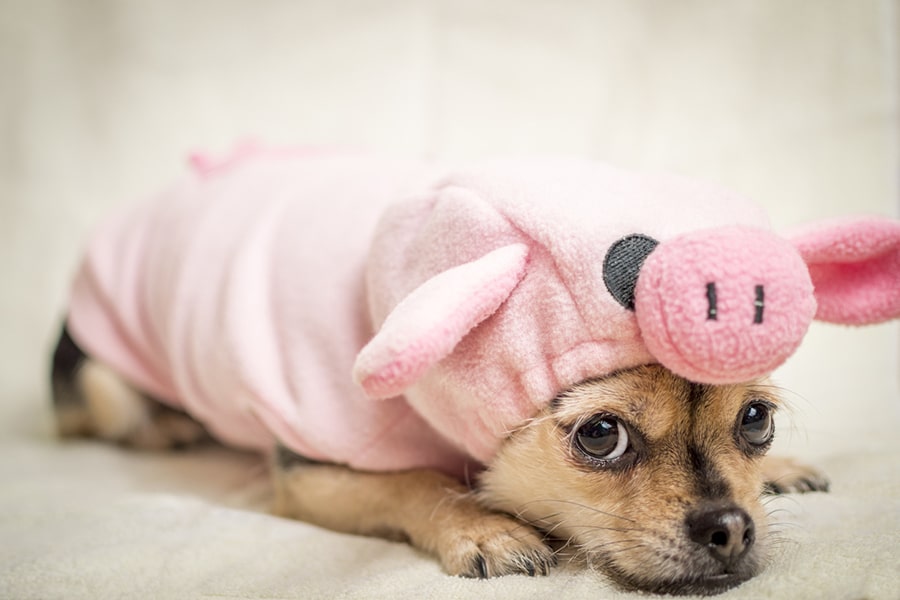
Taking care of your pet's coat is about more than making them look good.
Hair Versus Fur
Before we dive into cat and dog fur care, let's talk semantics. Do dogs have hair or fur? What about cats? The truth is that hair and fur are the same thing from a scientific perspective.
They both refer to thin fibers made of a protein called keratin that grows out of follicles in the skin. The difference is in the way we use these words. We tend to call them hair when we're talking about that stuff on top of human heads and fur when we're speaking about our pet's coat.
But it's not as straightforward as that. Some dogs with longer coats, such as Poodles or Irish Water Spaniels, are often referred to as having hair. Dogs also have guard hairs, which are harder and thicker than their soft undercoat. They help protect the skin and provide extra insulation from cold weather.
It's just as confusing for cats too. They definitely feel furry when they cuddle up in your lap, but they cough up hairballs. In the end, it doesn't really matter whether you call it fur or hair as long as you take great care of it.
Why is Cat and Dog Fur Care Important?
From appearances to preventing skin conditions, there are plenty of reasons to focus on your pet's fur.
Preventing Accidents
You may not think about safety as a reason for properly grooming your pet, but excess fur can obstruct their view and result in accidents. The same goes for furry ears, which can make it more difficult for pets to hear. Excess fur can also cause problems around the paws since it can pick up debris, which can injure their soft pads.
Keeping Up Appearance
It might sound shallow but looks matter to some degree when it comes to our pets. It's sad to see a sweet pet with dull, greasy, matted, or otherwise out-of-control fur. Staying on top of your pet's grooming will help keep them at their cuddly best.
If your pet's coat is not looking up to snuff, they might have a health condition. Visit your veterinarian if your pet's normally healthy-looking coat takes a turn.
Helping Pets Stay Comfortable
If you have a dog with a single coat, like a Bichon Frise or Doberman, you may want to give them a short cut to keep them cool in the summer. Remember not to shave your pooch all the way down to the skin. This puts them at a greater risk for sunburn when they're outside, and it can make them chilly when they come inside.
Double-coated dogs, such as Labradors and Huskies, shouldn't be shaved. During the hotter months, they shed most of their undercoat and the outer layer keeps them cool by allowing air to circulate near the skin. Shaving can change the texture of their coat and interrupt this natural cooling system.
Clipping or shaving your cat is not a good idea. Cats should be kept inside for health and safety reasons. Since they're not out in the heat, there's not much reason to give them a summer hairdo. Plus, the loud buzzing sound will likely scare a life out of them. They probably won't be too fond of the unfamiliar feel of close-cropped fur either.
Maintaining Skin Health
Caring for your pet's coat can help keep the pet's skin stay healthy and prevent skin conditions. For instance, regular brushing stimulates blood flow and boosts skin health.
It also removes loose hair, which can cause mats. When left alone, mats can lead to a skin infection or get so tightly wound that they restrict blood flow. Additionally, they make great hiding places for fleas and ticks, which can burrow in and feast on your pet nearly out of sight.

Common Fur Issues
Mats, burs, and ingrown hairs are all common fur troubles that can affect our pets.
How to Handle Matted Dog Fur
Mats form when your dog's fur gets tangled and wraps around itself. To avoid mats, brush your dog regularly with a brush that works well for their type of coat. For instance, an undercoat rake is great for dogs with a double coat since it can brush out tangles closer to the skin.
If your dog gets a mat, you should take care of it sooner rather than later. Mats tend to get thicker and more tightly wound as time goes by. These tips can help you get a mat out:
- First, try to loosen and isolate the mat with your fingers or brush.
- Next, use a slicker brush or comb to continue to work on it.
- Hold the mat firmly in your hand and comb it from the outside of the mat, not the area by the skin.
- Use small strokes and take breaks when your dog needs them.
- Give your pup treats and praise for sitting calmly.
- Avoid cutting out the mat unless you're properly trained and have the right kind of scissors. Otherwise, you could injure your dog.
For a stubborn mat, you can spritz it with a dog-safe detangling spray. If you can't get the mat out or your dog has lots of mats, you may need to enlist the expertise of a professional groomer.
How to Remove Mats from Cat Fur
Cats are typically pros at grooming themselves, but they can still get mats. If your cat has a mat, you can use the same tips for dealing with matted dog fur to try to get them out.
You may need even more patience to get a mat out of cat fur. Go slow and take your time. You might need to work on the mat in multiple short sessions. You may also want to contact your veterinarian. Under grooming can be a sign that your cat is sick.
Why do cats pull their hair out? Hair pulling can indicate that your cat is anxious or depressed. Get tips on taking care of your cat's mental health.
How to Get Burs Out of Dog Fur
Burs are spiky plant seeds that can attach themselves to your dog's fur. You should remove burs from your dog's fur as soon as possible since they can irritate your dog's skin and lead to infections. Here's how:
- Detangle the hair around the burr with your fingers and try to pull it out gently. You might need gloves to protect your skin if the bur is especially prickly. You can also use a metal comb or fork to work at the bur.
- Rub a small dab of vegetable, olive, or coconut oil over the bur to help slide it out. This can make your dog's fur greasy, so you may need to rinse the area or give your dog a bath when you're done.
- If the bur refuses to budge, crush it with pliers. Once it's broken into small pieces, it can be easier to pick or brush out of your dog's fur.
If you're having trouble removing the burs, you should call your veterinarian or groomer for advice.
What to Do About Ingrown Hairs
Hairs can grow into the skin causing small red pimple-like bumps. Ingrown hairs are more commonly seen on your pet's paws between their toes. They can also show up after clipping or grooming. They're often very itchy, and your pet may chew on or scratch at the area, which can lead to an infection.
Some ingrown hairs resolve themselves without treatment, but it's still a good idea to talk with your veterinarian. Red bumps can indicate other types of skin issues, so you'll want to rule those out.
Depending on the situation, your veterinarian might recommend a topical scrub to treat the ingrown hairs. In severe cases, they may need to be lanced.
Pet insurance can help you cover the costs of treatment for ingrown hairs and other skin conditions. Get answers to common questions about coverage.

How to Care for Your Pet's Fur
There's a lot you can do to help your pet's coat stay in top shape.
- Trim excess hair: You should groom your dog or cat at home by trimming the hair around their eyes, ears, paws, and hind-end as needed.
- Brush them regularly: Brushing gets rid of loose hairs, stimulates blood flow, and helps keep fur from getting tangled or matted. It also gives you a chance to detect fleas, ticks, and skin problems early.
- Keep their eyes, ears, and nose clean: Gently wipe off any goop or debris around their eyes, ears, and nose gently with a cotton ball or washcloth. If your pet has excessive or colorful discharge, you should contact your veterinarian.
- Give them baths: Dogs should be bathed every four weeks, give or take, depending on their breed and lifestyle. You may also need to give your cat a bath now and then if they get into something yucky.
Does the idea of giving your cat a bath stop you in your tracks? Get survival tips on how to safely bathe your cat.
Tips for Using a Dog Groomer
In addition to home fur care, you may need to take your dog to a professional groomer for regular trims or when problems like mats or burs come up. There are currently no state licenses for dog grooming, so you should do some research in advance. See who your local dog parent friends use, or check with your veterinarian for a recommendation.
You should talk to the groomer before making an appointment. Ask about their training, experience, and service offerings. Also, find out if they have any health requirements. For instance, some groomers require vaccines for diseases like rabies or kennel cough.
In addition, you can visit the facility to make sure you're comfortable with it. The place should look and smell clean, have sturdy equipment, and feel well-ventilated.
Considering a mobile groomer? Groomers that pull up to your driveway are becoming increasingly popular. While groomers on wheels can be more expensive, they're very convenient for busy dog parents. They're also helpful if your dog is the rare type who does not like riding in the car.
There's a lot you can do to care for your pet's fur to keep them safe, healthy, and cuddly.
The information presented in this article is for educational and informational purposes only and does not constitute or substitute for the advice of your veterinarian.
Helpful resources for pet parents
Browse categories
-

Choosing the Best Pet Toys (and DIYs You Can Make at Home)
Keep your pets happy and active with toys tailored to their personality, plus budget-friendly and fun DIY options!
-

Can Pets Feel Embarrassed?
It’s unclear if pets feel complex emotions like embarrassment.
-

How to Deal with Territorial Dogs
Get tips on how to handle a territorial dog and help them shed aggressive behaviors.

Browse Categories
(opens new window)
